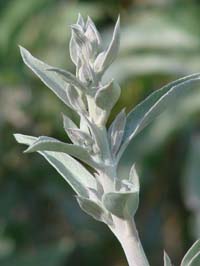White Sage

Bees, hummingbirds and blessings all are connected to the perennial subshrub White Sage (Salvia apiana), which is often referred to as being sacred. Counted among the blessings are the plant’s soaring spikes of white-to-lavender flowers that visually cool the landscape along with its large rosettes of lance-shaped, greenish-white foliage.
However, White Sage is far more than a pretty native plant of California. Historically, it provided food and medicine for a number of Native American tribes along the Pacific Coast.
Due to reverence for its usefulness and the powerful incense-like fragrance of the plant’s leaves when burning, California tribes incorporated White Sage into religious rituals. The plant’s smoke was intended to remove negative energy surrounding people and places.
Seeking Peace Through Smudging
Today, bundles of White Sage leaves are still tied together to create torch-like wands called smudge sticks for purification ceremonies. Yet smudging – using a bowl filled with burning sage or a smudge stick to waft sweet smoke around a person or place – isn’t limited to Native American religious ceremonies or to classroom lessons on early American cultures.
From San Francisco to London, homebuyers nervous about the economy and other problems in their lives are participating in smudging ceremonies to create a feeling of good luck and a peaceful fresh start in their new residences. One of the top smudging plants is White Sage.
Reporting on the phenomenon in 2011, The New York Times told about a real estate broker who conducts smudging ceremonies in apartments she needs to sell. The article also quoted an apartment buyer who likened smudging to the old Jewish tradition of well-wishing by bringing a gift of salt and bread to friends who move.
Whether you call it superstitious, soothing or sacred, smudging is going mainstream when people ask Yahoo "Where can I buy a smudge stick near Cleveland, Ohio." Diversity education intended to help students be more sensitive to cultures other than there own is responsible, in part, for creating interest in and respect for sacred smudging ceremonies.
Not far from Cleveland, a Cincinnati parochial school teacher compares Catholic rituals involving incense with Native American smudging in a cross-curricular lesson covering social studies and religious education. The teacher’s lesson plan about the beauty of creation notes that both fragrant substances are part of purification and celebration rituals involving prayer.
A different kind of lesson occurs along the coast of Southern California where illegal plant collecting has decreased White Sage in the wild. If you want white sage for smudging, it is best to grow your own, because it limits demand at stores that may receive the plant from poachers. Fortunately, White Sage is available through native plant nurseries. Flowers by the Sea is one such source. We have a deep respect for the religious and medicinal traditions associated with many of our plants, including White Sage. (However, we caution you to check with a physician before using any sage medically.) We also appreciate the fact that this plant is a magnificent magnet for pollinators, including bees, wasps and hummingbirds.
Growing Sacred White Sage
FBTS grows a strain of White Sage that performs well in many climates including the moist coastal areas of Northern California. For propagation, we use only the whitest and most compact of our plants, which can grow from 36 to 60 inches tall and spread 36 inches wide.
White Sage does well in full sun and well-drained soil in USDA plant hardiness zones 8 to 11. Although it grows slowly, it is a tough customer that can get by on little water and, in some areas, can grow in rocky soil.
Historically, California’s indigenous peoples used White Sage for many purposes in addition to smudging. These included grinding flour from the plant’s seeds for use in a food called pinole. They also made healing teas and medicines from the seeds.
Us? We like to burn the leaves in our house to sweeten the air. Outdoors, we enjoy the symphony of buzzing that surrounds White Salvia. It’s a different kind of sweetness. Contact us at FBTS if you have questions about any of our plants whether sacred or simply pretty.

 Salvia apiana
Salvia apiana
Comments
There are no comments yet.